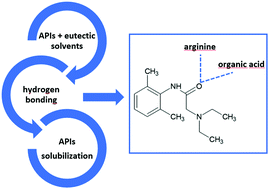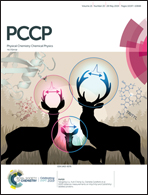Design of arginine-based therapeutic deep eutectic solvents as drug solubilization vehicles for active pharmaceutical ingredients†
Abstract
The solvation of lidocaine in three newly designed deep eutectic solvents is studied using combined experimental and theoretical methods that include density functional theory and molecular dynamics methods. The intermolecular forces between lidocaine and the hydrogen bond acceptors and hydrogen bond donors of the deep eutectic solvents were analysed regarding the type and the strength of inter- and intra-molecular bonding. The structure, composition and properties of the lidocaine solvation shells are analysed together with the possible lidocaine-clustering around the studied deep eutectic solvents and their constituent molecules. Furthermore, the changes in the solvent structures upon lidocaine solubilization are also studied. Natural product-based eutectic solvents showed considerably high solvation of lidocaine in all three deep eutectics based on the strong solute–solvent intermolecular interactions accompanied by a slight volume expansion and minor solvent structural changes. These non-toxic and almost null-volatile therapeutic deep eutectic solvents can be considered as suitable solubilization media for developing pharmaceutical applications and they can be considered as effective drug delivery vehicles for active pharmaceutical ingredients.



 Please wait while we load your content...
Please wait while we load your content...